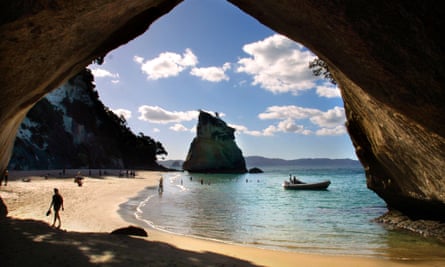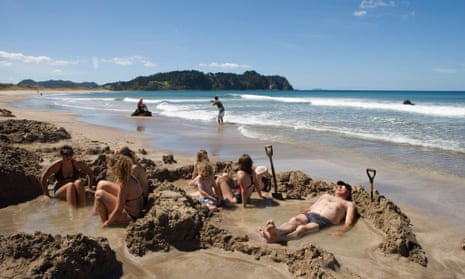The Coromandel’s charms are no secret — tens of thousands flock here from the North Island’s urban centres and beyond every summer. Yet it remains just far enough from the madding crowds, as the intermittent weakness of phone signal and the car radio’s scratchiness can attest.
The peninsula is full of diddy towns, but you can add an extra zero to the populations of many during high summer. Between these townships, there’s white, craggy coastline, green, velvety conifers and creamy, dreamy sands. A mix of pony-tailed painters, affluent Aucklanders and laid-back locals use it as their hideaway and, as a result, the pace of life needn't rise above a trot.
Stunning views from Cook's corner
Captain Cook landed on the beach that now takes his name in November 1769, to watch Mercury (hence the Bay’s name) cross the sun. After some astronomical calculations Cook worked out the latitude and longitude, put New Zealand on a map and, while he was at it, planted a British flag on Kiwi soil and claimed the territory for King George III. Never one for resting, Cook then declared a nearby rock formation so crooked that it resembled the Bard’s nose, and thus Shakespeare’s Cliff was born.

A wet and windy Wednesday in Whitianga puts paid to fishing and kayaking trips around the bay, but failed to prevent a choppy ride on a glass-bottomed boat to stunning Cathedral Cove. The following day (a less blustery one) I took in the same spots from land with Aotearoa Tours’ excellent guide Darryl – who came equipped with that trademark Kiwi sense of humour and exceptional local knowledge. The view of Mercury Bay from Shakespeare’s Cliff is stunning and Cathedral Cove is well worth a testy walk down through the Kauri Gum.
Hot pools and art on every wall
No trip to the Coromandel peninsula would be complete without stopping off at Hot Water beach. Herein lies the problem, as the only attraction in the area that everyone does, it can be a scrum in summertime.
Nevertheless, there’s good reason for its popularity; hire a shovel, dig yourself a pool and wallow in the piping hot water with steam billowing from the sand around you. It’s like a bath that never gets cold, until the incoming tide breaks its barriers. When bath time’s over, and if you're feeling particularly clever, you can use the 67C sands to boil an egg or cook a fish.
Just up the road in Whitianga is the wonderful Lost Spring. First things first, this is the only place I visited that insists you leave the sprogs behind. And rightly so, it’s the ultimate hiding place.
Get a massage – trust me, it’ll unpick even the most knotted back – a seafood platter and a cocktail (best enjoyed in the hottest of the geo-thermal pools, the Crater Lake, which sits at around 40C and is sourced from a geothermal spring 667m under Whitianga). There are cooler pools for the less masochistic. An afternoon spent here should serve to soothe even the most troubled soul.
If the novelty of Hot Water beach isn’t your thing, there are plenty of stunning, more conventional sands about. A left-hand break gives Whangamata super surf, while nearby Opoutere is great for twitchers, and Onemana for those looking for total calm.
An influx of hippies in the latter half of the last century saw the Coromandel develop into an arty haven. Almost every restaurant, cafe, B&B and winery acts as a gallery with locally produced work hanging, and often selling, on every wall. Otherwise, Topadahill Studio at Opoutere beach, Little Gallery of Fine Arts in Tairua and Bread & Butter Gallery in Whitianga are all worth a visit.
Around Paeroa and Waihi on two wheels, or four
For all its charms, Paeroa, the southernmost tip of the peninsula, can’t seem to decide which claim to fame it wants; the whole town seems a homage — in giant bottle, banner and bunting form — to Lemon & Paeroa (L&P), that sickly sweet citrusy can of goodness, but it’s also the self-styled antiques capital of New Zealand. The town’s main street has plenty of knickknacky-style shops, shifting seasoned goods that may or may not actually be antique.
This article includes content provided by Instagram. We ask for your permission before anything is loaded, as they may be using cookies and other technologies. To view this content, click 'Allow and continue'.
Paeroa provides a convenient starting point for the Hauraki Rail Trail cycle. Take on the gentle 14km jaunt to Waikino or the ever-so-slightly more challenging trip to Waihi. A crucial pit-stop comes at Ohinemuri Winery, where I sampled the produce with Horst Hillerich, the German proprietor. And not just the fruity Wairau valley sauvignon blanc and excellent Omoka Springs pinot gris, but homegrown herbs and veggies, homemade chutneys and fudge.
Back to the ride, which takes you through the 1.1km Karangahake's rail tunnel in almost pitch darkness. It’s also worth checking out the staircase-style Owharoa Falls, Victoria Battery and the Windows Walk, which offers views of the spectacular Karangahake Gorge and Ohinemuri River through holes in the cliff face.
Whether you cycle or drive there, Waihi is a town well worth a visit due to a whopping great hole in the ground — a mine named Martha — that folk have been taking gold out for well over a century. Unlike Paeroa, Waihi’s identity is clear: it’s a gold town but, with the mine set to close for the second time in the none-too-distant future, it’s a gold town at a crossroads.
This article includes content provided by Instagram. We ask for your permission before anything is loaded, as they may be using cookies and other technologies. To view this content, click 'Allow and continue'.
Thus it’s exciting to hear whispers of adventure sports in the shaft and to see the development of the Gold Discovery Centre, to commemorate and inform of the region’s proud history. Until this opens in September 2014 and the mine closes, take the excellent goldmine tour to get up close and personal with the extraction process, see the majestic Cornish pumphouse and walk around Martha’s 4km perimeter. This is New Zealand, so inevitably there’s a full panorama of stunning scenery and, considering she’s a mine, Martha ain’t too ugly at all.
From Waihi, there’s a challenging, winding, hour-long drive up to Tairua, through rugged forest and along jagged coast. Like many of the area’s drives it’s not one for the weary, with hairpin bends and distracting scenery aplenty.
Friendly B&Bs provide a personal touch
I spent the night in two remarkably similar and equally brilliant B&Bs. The first, Sunlover Retreat in Tairua, is – despite the name – not a nudist colony and is run by the exceptionally friendly Donna Brooke and her rumbustious labradoodle, Jack. 24 hours later and I’m at Within the Bays in Whitianga. There I’m treated to an equally warm welcome and special stay by Hans and Annemarie Apers, a Dutch couple.
Both stays share the same strengths. They are perched high up above their towns, and offer stunning views of the harbours and beyond, with orcas and dolphins sometimes in sight. Both were designed by their proprietors and fulfil the obligatory bed and breakfast requirements brilliantly.
The personal touches are a treat; from the homemade goods — enjoy Hans’ beer, Annemarie’s croissants and Donna’s bread, to the reams of local expertise on offer, the personalised, handwritten bedside note left at Sunlover and the leaving gift from Within the Bays.
Craft beer and local seafood
Every man and his dog has a boat in these parts, so fine seafood is two a penny. In Whitianga, I ate at Squids on Blacksmith Lane, where the fish pie was homely and wholesome and contained local, juicy, muscular mussels. Over the road is the highly recommended — if slightly fancier — Salt Bar & Restaurant, and it’s worth popping into the Whitianga Hotel next door for a beer from the impressively-stocked bar or a fine-looking feed.
Back in little Tairua, the options are less plentiful but Shells is a big, open-plan place, where succulent Waikato beef and an excellent seafood chowder are the highlights of a varied menu. There fellow patrons trade tales of their seafaring day, before an open fire.
These days New Zealand is a country with craft beer dripping from every pore. But a trip to the steaming sand should not pass without a stop off at Hot Water Brewing Company, where the excellent brasserie (super "fush'n'chups") is open until late and the beers are so good it’s unlikely the place will remain a secret for long.
Watch head brewer Dave Kurth — formerly of Sharp’s (home of delicious Doom Bar) in Cornwall, in the UK — at work and sample the citrusy Steamer, passionfruit flavours of Pale and chocolatey smooth Porter. Also, keep an eye out for Lala Coffee, roasted in Coromandel town and delicious all over the peninsula.

Comments (…)
Sign in or create your Guardian account to join the discussion